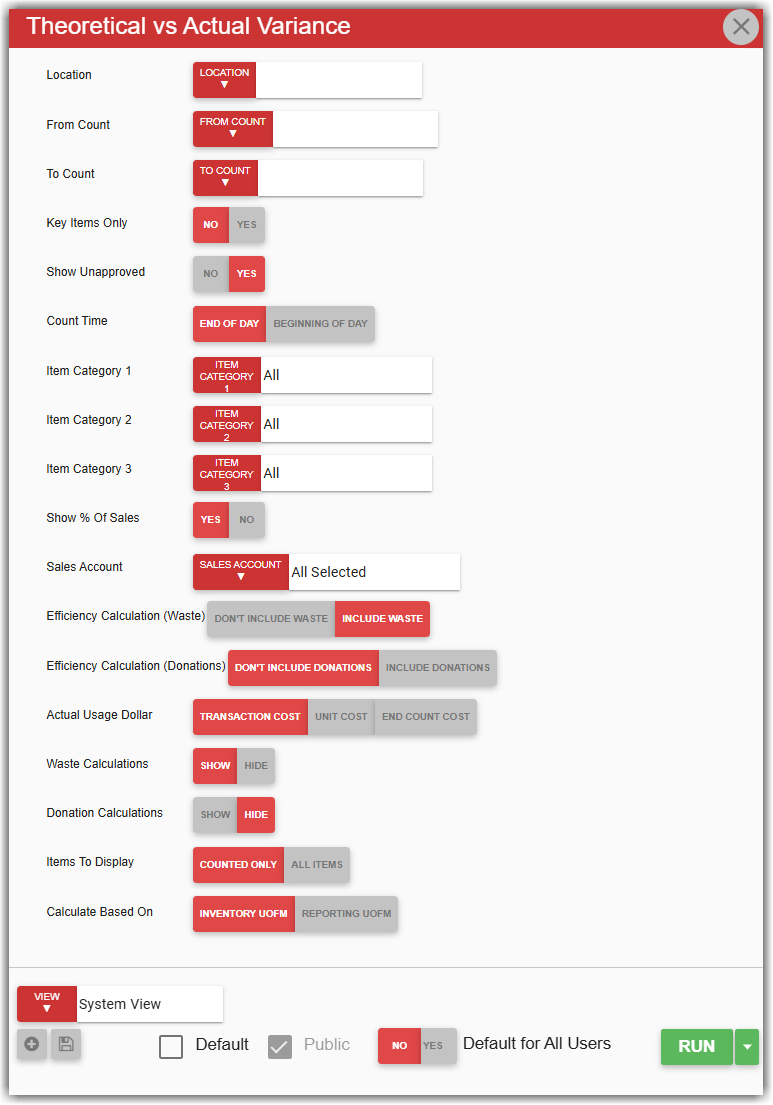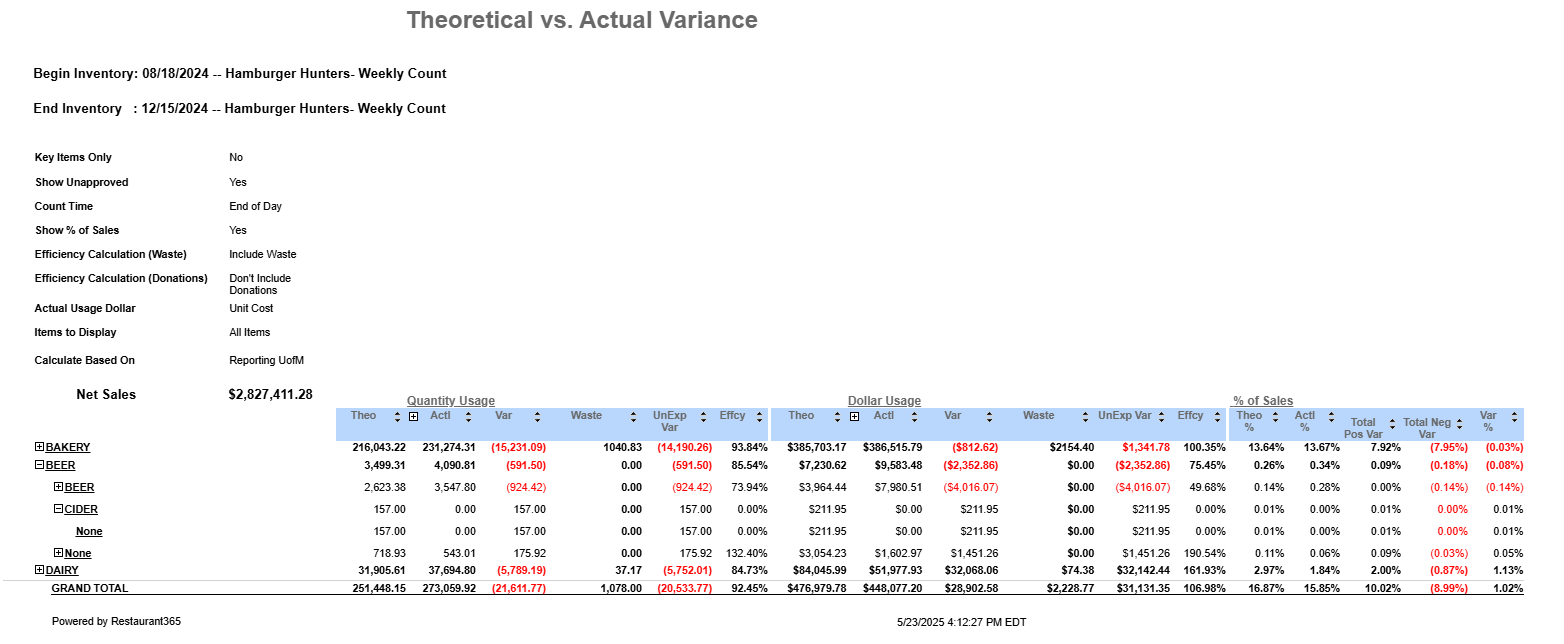This feature is in beta for select customers. Contact your CSM for more information.
The Theoretical vs Actual Variance report compares the theoretical usage of certain inventory items or categories against actual data, in terms of both quantities and dollar amounts and their percent of net sales. It also shows and compares the variance between them.
The Theoretical vs Actual Variance flags variances that are in excess. This means that the location used more product than it ideally should have. The inclusion of positive and negative variance columns allow users to get a snapshot of how an item category is contributing to the variance.
In addition to theoretical vs actual values and variances, this report allows users to expand/collapse the ‘actual’ usage column. This function opens columns that show what is calculated into the usage, including:
Beginning inventory count
Transfers
Ending inventory count
Purchases (Items on AP invoices/credit memos)
This report provides a deeper dive into the quantity, cost, and use of each purchased item to find solutions to limit the biggest food cost variances.
Users can drill down into the items that make up the item categories and their transactions. Users can also view a full list of all the items.
This report calculates theoretical usage using historical POS (point of sale) and PMIX (menu item) data.
Navigation
The My Reports search bar can be used to search R365's entire catalog of reports.
- Open the Reports app.
- Navigate to My Reports.
- Enter all or part of the report name in the search bar.
- The Results tab will open with the list of search results.
- From beneath the report name, click Run to run the report with the selected report view.
-OR-
Click Customize to adjust the report parameters and run the report.

Report Parameters

Field | Description |
|---|---|
Location | The location that the report is run for. The location selection will determine the counts that are available in From Count and To Count. |
From Count | Starting inventory count from which to pull data. The From Count and To Count selections create a date range for the generated report to display data. |
To Count | Ending inventory count from which to pull data. The From Count and To Count selections create a date range for the generated report to display data. |
Key Items Only | If Yes is selected, the report includes key items only. |
Show Unapproved | If Yes is selected, the report includes data from unapproved transactions.
|
Count Time | Time of day from which transactions are pulled. Options include:
|
Item Category 1, 2, 3 | Filters the items that appear in the report by the selected item categories. |
Show % of Sales | If Yes is selected, the Actual %, Theo %, Variance %, Total Positive Variance, and Total Negative Variance columns appear in the report. |
Sales Account | Filters the report to show data for selected sales accounts. |
Efficiency Calculation (Waste) | Include or exclude waste in percentage calculations. |
Efficiency Calculation (Donations) | Include or exclude donations in percentage calculations. |
Actual Usage Dollar | Determines whether item costs are based on the:
|
Waste Calculations | Shows or hides inventory that was documented in the waste count. |
Donation Calculations | Shows or hides inventory that was documented in the donation count. |
Items to Display | If Counted Only is selected, the report shows only inventory count items. |
Calculate Based On | Determines whether the report is calculated based on the default Inventory UofM 1 or the item's Reporting U of M. |
View options | Provides the user with options to select, save, edit, or delete a report view. |
Run | Generates the report. |
Report Columns

The header displays the following information:
Begin Inventory - First inventory count included in the report.
End Inventory - Final inventory count included in the report.
Report Parameters - The report parameter selections for the data shown.
Net Sales - Total net sales for all items in the report.
Column | Description |
|---|---|
Item Categories | Item categories can be clicked to drill down into the items that make up the category. |
Count UofM | Unit of measure for each item as used when conducting an inventory count. This UofM is either the Inventory UofM1 of the Reporting UofM. This is dependent on what is selected in the report parameters.
|
Avg Cost | Average cost per unit.
|
Quantity Usage | |
Theo | Theoretical number of items used. |
Begin | Starting quantity of each item as shown in the first inventory count that was included in the report.
|
Purch | Quantity of items purchased for the location.
|
Xfer | Quantity of items transferred to or from the location.
|
End | Final quantity of each item as shown in the last inventory count that was included in the report.
|
Actual | Actual number of items used. When expanded, the Beginning, Purchased, Transfer, and End columns appear. |
Var | Difference between the theoretical amount and the actual amount. This is theoretical minus actual usage. |
Waste | Number of items that were not used and therefore went to waste. These appear as positive values.
|
Donation | Number of items that were donated.
|
UnExpl Var | Difference between variance and waste. This is theoretical minus actual plus waste. This column can help users better understand why certain items have larger variances than others. |
Effcy | The theoretical quantity over the actual quantity used. This shows how efficiently this item is being used. |
Dollar Usage | |
Theo | Total theoretical cost of the item.
|
Actual | Total actual cost of the item. When expanded, the Beginning Cost, Purchased Cost, Transfer Cost, and Ending Cost appear.
|
Var | Difference between the actual cost and the theoretical cost. This is theoretical minus actual cost. |
Waste | Cost items that were not used and therefore went to waste.
|
Donation | Cost of items that were donated.
|
UnExpl Var | Difference between variance and waste. This column can help users better understand why certain items have larger variances than others. |
Effcy | The theoretical cost over the actual cost of items used. This shows how efficiently this item is being used. |
% of Sales
| |
Theo % | Percentage of theoretical sales. |
Actl % | Percentage of actual sales. |
Total Pos Var | The item category’s total variance if the variance is a positive value. |
Total Neg Var | The item category’s total variance if the variance is a negative value. |
Var % | Difference between actual percent and theoretical percent of sales. |
The totals in the column all add up to the row labeled Grand Total, which shows the grand total of all values in the column.
R365 Tip
Clicking the Grand Total label will open a new tab with a full list of every item considered for this report.
This opens a list view of all items compared to one another.
Email, Export, or Print the Report
This report can be emailed, exported, or printed in custom formatting directly from the reporting window. Learn more about how to send, export, or print this report.


